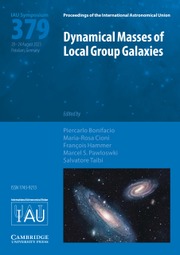No CrossRef data available.
Article contents
Revisiting mass estimates of the Milky Way
Published online by Cambridge University Press: 30 October 2025
Abstract
We use the rotation curve from Gaia data release (DR) 3 to estimate the mass of the Milky Way. We consider an Einasto density profile to model the dark matter component. We extrapolate and obtain a dynamical mass  at 112 kpc. This lower-mass Milky Way is consistent with the significant declining rotation curve, and can provide new insights into our Galaxy and halo inhabitants.
at 112 kpc. This lower-mass Milky Way is consistent with the significant declining rotation curve, and can provide new insights into our Galaxy and halo inhabitants.
Information
- Type
- Poster Paper
- Information
- Proceedings of the International Astronomical Union , Volume 19 , Symposium S379: Dynamical Masses of Local Group Galaxies , December 2023 , pp. 116 - 119
- Copyright
- © The Author(s), 2025. Published by Cambridge University Press on behalf of International Astronomical Union
References
Sylos Labini, F., Chrobáková, Ž., Capuzzo-Dolcetta, R., et al. 2023, ApJ, 945, 3.CrossRefGoogle Scholar


